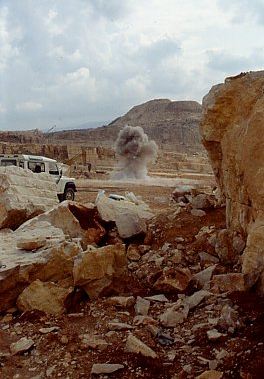
Cava Dell'Erba, 1992

Italiano
DELFINO M. & BAILON S., 2000. Erpetofauna del Pleistocene inferiore di Cava Dell'Erba e Cava Pirro (Puglia, Italia meridionale). The Herpetological Journal, 10: 95-110. [in inglese]
I riempimenti del Pleistocene inferiore delle fessure di Cava Dell'Erba e Cava Pirro (Apricena, Puglia, Italia meridionale) hanno restituito abbondanti resti di vertebrati. Lo studio di più di 14.000 resti di Anfibi e Rettili ha rivelato la presenza dei seguenti 18 taxa (6 Anfibi e 12 Rettili): Triturus cf. T. alpestris, T. vulgaris gr., Bufo bufo, Bufo viridis, Hyla arborea gr., Rana cf. R. ridibunda vel R. kl. R. esculenta, Testudo hermanni gr., Emys orbicularis, Mauremys sp., Pseudopus sp., Podarcis sp., Lacerta sp., Blanus sp., Hierophis viridiflavus, Elaphe longissima, Coronella cf. C. austriaca, Natrix natrix, Vipera aspis gr. Alcuni dei resti attribuiti a "Colubrines" indet. potrebbero rappresentare taxa diversi da quelli elencati.
La notevole diversità tassonomica e la buona conservazione ed abbondanza del materiale collocano questa erpetofauna fra le più interessanti del Quaternario europeo.
Alcuni dei taxa identificati sono riportati per la prima volta in Italia. Altri sono di particolare interesse poiché contribuiscono a colmare intervalli passati o presenti in areali disgiunti in senso Est-Ovest.
Le necessità ecologiche dell'erpetofauna suggeriscono la presenza di un paesaggio tipicamente mediterraneo: un ambiente relativamente asciutto con corpi d'acqua temporanei (almeno i più vicini al sito) circondati da una copertura arborea aperta e/o cespugliosa.
Parole chiave: Anfibi, Rettili, Paleontologia, Pleistocene inferiore, Villafranchiano superiore, Italia.
English
DELFINO M. & BAILON S., 2000. Early Pleistocene herpetofauna from Cava Dell'Erba and Cava Pirro (Apulia, Southern Italy). The Herpetological Journal, 10: 95-110.
The Early Pleistocene fissure fillings of Cava Dell'Erba and Cava Pirro (Apricena, Apulia, Southern Italy) have yielded abundant fossil vertebrate remains. The study of more than 14.000 amphibian and reptile remains revealed the presence of the following 18 taxa (6 amphibians and 12 Reptiles): Triturus cf. T. alpestris, T. vulgaris group, Bufo bufo, Bufo viridis, Hyla arborea group, Rana cf. R. ridibunda vel R. kl. R. esculenta, Testudo hermanni group, Emys orbicularis, Mauremys sp., Pseudopus sp., Podarcis sp., Lacerta sp., Blanus sp., Hierophis viridiflavus, Elaphe longissima, Coronella cf. C. austriaca, Natrix natrix, Vipera aspis group. Some of the materials referred to "Colubrines" indet. could represent taxa different from those listed above.
The high taxonomic diversity, good preservation and abundance of the materials place this herpetofauna amongst the more informative ever recovered in European Quaternary.
Some of the identified taxa are reported for the first time in Italy. Others are of particular interest as they contribute to fill the present or past gap in their E-W disjunct ranges.
The amphibian and reptile ecological requirements suggest the presence of a typical Mediterranean landscape: a relatively dry environment with water bodies of temporary nature (at least those closer to the sites) surrounded by scattered trees or/and bushes.
Keywords: Amphibians, Reptiles, Palaeontology, Early Pleistocene, late Villafranchian, Italy.
Front page